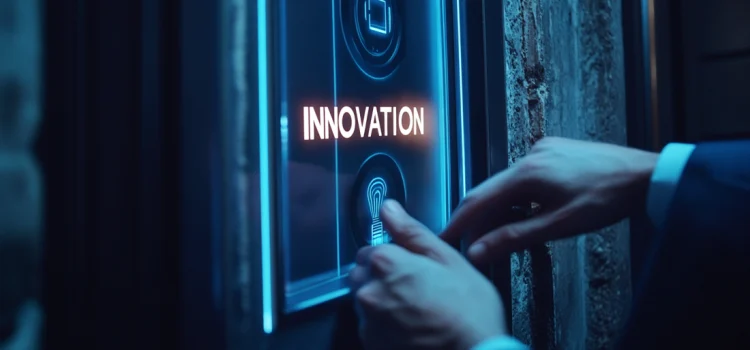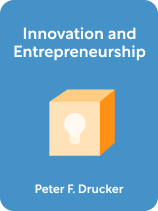

This article is an excerpt from the Shortform book guide to "Innovation and Entrepreneurship" by Peter F. Drucker. Shortform has the world's best summaries and analyses of books you should be reading.
Like this article? Sign up for a free trial here.
Do you know how to get innovative ideas? Where are key places to find innovation?
Once you’ve achieved an entrepreneurial mindset and structured your business to reward innovation, it’s time to go out and find that innovation. To do this, businesses should adopt a systematic approach to identifying opportunities for innovation rather than relying on rare strokes of genius.
Here are the places where innovation will come to you.
Where to Find Innovation
Peter F. Drucker lists many avenues a determined entrepreneur can investigate when looking where to get innovative ideas, including analyzing business successes and failures, identifying discrepancies between people’s expectations and reality, and watching for changes in the market and the public—all of which are preferable to trying to invent something new from whole cloth.
New innovations should be simple and focused, addressing a specific problem or opportunity. Drucker cautions against overly complex or futuristic innovations, as they often lack practical, present-day applications. Instead, businesses should prioritize innovations that create a tangible economic impact by changing consumer behaviors or optimizing existing processes. Companies should play to their strengths and areas of expertise, recognizing that innovation requires continuous effort and commitment. By embracing a disciplined approach to innovation, organizations can uncover opportunities that align with current market realities as well as their own core competencies, increasing their likelihood of success.
| Grounding Your Innovations In a sense, putting resources into innovation is a form of investment in your company’s future. Therefore, some basic rules of investing should apply. Knowing your company’s “circle of competence,” as Charlie Munger calls it in Poor Charlie’s Almanack, can ensure investments in innovation align with your company’s expertise. Munger and his business partner Warren Buffett only say yes to investments they understand and that can thrive in any market situation, while avoiding those they consider too esoteric. By sticking to your company’s competence circle, you can focus on a few, high-quality innovations instead of being tempted by numerous seemingly promising, but uncertain, ventures. That doesn’t mean you should have tunnel vision. Rather, your business’s competencies should grow outward from its core principles. In Built to Last, Jim Collins and Jerry I. Porras write that long-lasting companies don’t evolve and innovate at the expense of their central ideals. Instead, they distinguish between practices that change and those that don’t. For instance, Nintendo started by selling playing cards a century before there was a video game industry. Its methods have changed, but its core principle of creating enjoyable games has not. A core philosophy and growing circle of competence defines the boundaries between what a business should and shouldn’t do, then drives progress forward within those lines. |
1. Surprise Success and Failure
Innovation often comes wrapped in unexpected packages, such as unforeseen successes or failures. Companies must be ready to respond to these unanticipated events, as they can offer valuable insights into potential growth opportunities. Surprise successes present a challenge because they often undermine a business’s basic assumptions or else go completely unnoticed. Surprise failures are similarly disruptive, as they sometimes necessitate organizational changes, a shift in resources, or new business assumptions altogether.
Drucker writes that the clearest sign of a potential innovation is unexpected business success. However, capitalizing on a surprise triumph can be a challenge for a business that’s deeply entrenched in its traditional ways of operating. This is especially true if the success undermines the core product or service upon which the company has built its identity. For instance, if a prestige winery makes an unexpectedly large number of sales through a discount liquor chain, this might shatter its self-image as a business that caters to high-end, luxury tastes. However, if a business can embrace an open and humble perspective, it can transform surprise success into a catalyst for unlocking new avenues for growth.
(Shortform note: Despite signaling opportunities for innovation, a runaway success can actually be dangerous, especially for startups. Rapid growth can cause financial strain by increasing a business’s operating costs and the size of the workforce it needs, both of which can trigger a cash flow crisis. Unsustainable growth can lead to employee burnout and lower levels of customer satisfaction, thereby undermining the company’s reputation. Therefore, if you follow Drucker’s advice to analyze your success for innovative opportunities, don’t lose track of what your company needs to ensure its long-term survival.)
Surprise successes slip under the radar when organizations aren’t actively looking. Drucker warns that shifts in customer behavior and emerging market trends can go unnoticed if they fall outside the company’s established reporting mechanisms, which can prove disastrous if competitors take advantage of these opportunities first. To avoid missing out, leaders must continuously watch for signs of unanticipated success. When surprises occur, management must honestly assess what organizational changes may need to happen to nurture and expand on these wins, allocating top talent and resources if needed.
(Shortform note: One tool for detecting hidden patterns in customer behavior that wasn’t available in Drucker’s time is artificial intelligence (AI). Businesses can use AI to spot emerging market trends and to detect anomalous sales patterns that human analysts may otherwise miss. Using modern machine learning techniques, AI can process massive amounts of data and spot unexpected patterns in real time, such as unusual fluctuations in customer purchasing habits. As of yet, AI can’t make business decisions, but it can help entrepreneurs gain a deeper understanding of their consumers and their business’s market dynamics.)
2. The Mismatch and the Missing Link
The lesson to be learned from successes and failures is that opportunities to innovate can be found in the discrepancies between how things are and how people think they ought to be. In particular, Drucker emphasizes mismatches in economic assumptions, customer value perceptions, and inefficient industrial processes as fertile ground for innovators.
First, Drucker states that economic realities that defy long-held assumptions are powerful indicators of innovation opportunities. For instance, when increasing demand for a product fails to translate into higher profits, it signals a disconnect between conventional wisdom and market forces. Mismatches between assumptions and reality often stem from deeply ingrained industry practices that have gone unchallenged for many years. Such discrepancies create openings for innovators to disrupt the status quo by introducing more effective practices. However, Drucker emphasizes that to successfully capitalize on these opportunities requires that solutions be supported by readily available technology to increase their ease of adoption.
Another avenue for innovation stems from the disconnect between how a business values its product and the actual values that drive its customers. Drucker points out that a product’s users may be seeking to fulfill entirely different needs than those envisioned by its creators. Savvy innovators will reframe their question from “What is our product?” to “What do people need from our product?” Pricing and positioning your products in the market based on what the customer wants to buy, rather than what the manufacturer wants to sell, unlocks a way to bridge this difference in values and create an entirely new market for a product.
3. Changes in Markets, People, and Perceptions
The previous opportunities for innovation all occur within an industry or between that industry and its consumers. The next set of signals that innovation is needed—and will likely be successful—stem from changes outside your organization’s sphere of control. Specifically, Drucker writes that entrepreneurs ought to keep a keen eye on market shifts, demographic changes, and the evolution of public perception.
Entrepreneurs should always watch for changes in a market or industry. Drucker explains that when the basic elements of a market start to shift, larger companies that are set in their ways often struggle to adapt, creating an opening for creative thinkers. This is especially true when industries experience rapid growth, which usually signals an impending structural shift in that industry as a whole. For instance, the auto industry’s rapid expansion in the 20th century gave birth to the “Big Three” US automakers—Ford, GM, and Chrysler. However, with demand still on the rise in the turbulent 1960s and ’70s, the Big Three failed to adapt soon enough, opening the door for foreign automakers to introduce less costly and more fuel-efficient cars.
Demographic shifts also pave the way for innovation, since they provide a broad indication of who will be spending money and on what. Fluctuations in the population’s average age or education level can give you a glimpse into the future pool of consumers. Drucker writes that contrary to what some business leaders believe, these changes don’t always occur slowly—in the 20th century, demographic changes happened quickly, such as the famous post-World War II “baby boom.” The key lies in interpreting how and when these changes will affect consumer behavior. By keeping an eye out for major demographic shifts, you can design new products and services for markets as they emerge.
4. Pure Invention
The final innovation strategy—and one that Drucker doesn’t actually endorse—is that of innovation purely from scratch. Drucker objects to the romanticized notion of genius inventors and their groundbreaking products. Launching totally new inventions is highly risky and usually depends on the convergence of multiple factors in the market—a single missing ingredient may delay or derail your product’s success.
According to Drucker, breaking into the market with brand-new inventions is a losing game—for each success, there are countless failures, and predicting which invention will take off is a near-impossible task. As alluring as they may seem, new inventions carry higher risks compared to other types of innovation opportunities, as well as very long development periods from concept to application, followed by another lag from development to market entry, with a total average time in development spanning 30 years for a single invention to grow into wide acceptance by the public.
Furthermore, Drucker points out that innovation through invention rarely hinges on a single new development—instead, it commonly depends on the union of two or more technologies or practices. For instance, even though cathode ray tubes (CRTs) were invented in 1897, it wasn’t until Philo Farnsworth leveraged the newly discovered “photoelectric effect” that he could build the first CRT-based television. Therefore, until every piece of the puzzle is ready, an innovation isn’t ripe for deployment. It follows, then, that your first step must be to analyze everything that needs to exist for your invention to succeed. Not doing so can result in a misfire—either your innovation will bomb, or a competitor will swoop in and seize the advantage after you fumble.

———End of Preview———
Like what you just read? Read the rest of the world's best book summary and analysis of Peter F. Drucker's "Innovation and Entrepreneurship" at Shortform.
Here's what you'll find in our full Innovation and Entrepreneurship summary:
- Peter F. Drucker’s template for structuring an entrepreneurial organization
- Strategies for bringing innovations to the market
- How to manage entrepreneurial startups






